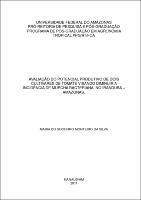| ???jsp.display-item.social.title??? |


|
Please use this identifier to cite or link to this item:
https://tede.ufam.edu.br/handle/tede/2652| ???metadata.dc.type???: | Dissertação |
| Title: | Avaliação do potencial produtivo de dois cultivares de tomate visando diminuir a incidência de murcha bacteriana, no Iranduba-Amazonas |
| Other Titles: | Evaluation of the productive potential of two tomato cultivars aiming to reduce the incidence of the bacterial wilt in Iranduba-Amazonas |
| ???metadata.dc.creator???: | Silva, Maria do Socorro Monteiro da  |
| ???metadata.dc.contributor.advisor1???: | Rodrigues, Maria do Rosário Lobato |
| ???metadata.dc.description.resumo???: | O tomate, pertencente à família das solanáceas, representa uma das hortaliças mais consumidas no Estado do Amazonas, sendo que a maioria dos frutos comercializados é proveniente dos estados do sul, sudeste e centro-oeste, onde as condições climáticas são mais amenas. A Murcha Bacteriana, causada pela bactéria Ralstonia solanacearum, constitui-se como uma das doenças mais importante para a cultura. Devido às exigências edafoclimáticas do tomateiro, sua produção é praticada com mais intensidade nas regiões mais frias e secas do Brasil. Já nas regiões do trópico úmido, as condições de clima, permanentemente quente e úmido, favorecendo a sobrevivência desta bactéria é o principal motivo que desestimula a produção da cultura nesta região devido a baixa produtividade. Com a finalidade de indicação de inovações tecnológicas que possibilitem a produção desta hortaliça em grande escala, este trabalho objetiva avaliar o potencial produtivo e comercial de duas cultivares de tomate e técnicas de manejo visando diminuir a incidência de murcha bacteriana, em sistema de cultivo protegido, na região de Iranduba AM. Os cultivares utilizados, C-38 e Santa Bárbara, ambos desenvolvidos pela Embrapa Amazônia Oriental, Belém/PA com histórico de tolerância à murcha bacteriana, foram plantados sucedendo o milho, em dois tratamentos e em outro, em cultivos sucessivos. Os dados obtidos evidenciaram a importância da combinação de material vegetal resistente com técnicas de cultivos, pois nos sistemas de manejo em que o tomate foi plantado em sucessão ao milho, apresentou mortalidade inferior ao sistema de manejo convencional, sendo que a produtividade obtida, na média do experimento, de 22,65 t ha-1foisuperior à média do estado do Amazonas(14,60 t ha-1). Comparativamente ao cultivar Santa Bárbara, o cultivar C-38 apresentou maior produtividade e características de formato e número de frutos com maior aceitação pelo mercado interno |
| Abstract: | The tomato, it belongs to the Solanaceae family, is one of the most consumed vegetables in Amazonas State, and the most marketed fruits come from the southern and southeast states, where weather conditions are more pleasant. Bacterial wilt, caused by the bacterium Ralstonia solanacearum, was established as one of the most important diseases for the tomato crop. Due to soil and climatic requirements, the tomato production is practiced with more intensity in the coldest and the driest regions in Brazil (Southeast, South and Midwest). In the humid tropical regions, the climatic conditions, permanently hot and humid, favors the survival of this bacterium that is the main reason that discourages the production of this crop in this region due to low productivity. With the purpose of indicating the technological innovations that enable the production of this vegetable in large scale, this study aims to evaluate the potential production and trade of two tomato cultivars and management techniques to decrease the incidence of bacterial wilt in protected cultivation systems, in the region of Iranduba - Amazon. The tomato cultivars used were C-38 and Santa Barbara, both developed by Embrapa Eastern Amazon, Belém/PA with a history of tolerance bacterial wilt, they were planted succeeding maize, in two treatments and in other, in successive crops. The data evidences the importance of combining techniques with resistant plant material from crops, because in the management systems that the tomato was planted in succession to maize, mortality was lesser than conventional management system and the productivity (approximately 22,65 t ha-¹) was higher than the average of the Amazonas State (approximately 14,60 t ha-¹). Comparated to the Santa Barbara cultivars, the C-38 cultivar showed higher productivity and characteristics of shape, weight and number of fruit with greater acceptance by the interal market |
| Keywords: | Solanum lycopersicum Ralstonia solanacearum Rotação de cultura Plasticultura Solanum lycopersicum Ralstonia solanacearum Crop rotation Plasticulture |
| ???metadata.dc.subject.cnpq???: | CIÊNCIAS AGRÁRIAS: AGRONOMIA |
| Language: | por |
| ???metadata.dc.publisher.country???: | BR |
| Publisher: | Universidade Federal do Amazonas |
| ???metadata.dc.publisher.initials???: | UFAM |
| ???metadata.dc.publisher.department???: | Faculdade de Ciências Agrárias |
| ???metadata.dc.publisher.program???: | Programa de Pós-graduação em Agronomia Tropical |
| Citation: | SILVA, Maria do Socorro Monteiro da. Evaluation of the productive potential of two tomato cultivars aiming to reduce the incidence of the bacterial wilt in Iranduba-Amazonas. 2011. 110 f. Dissertação (Mestrado em Agronomia Tropical) - Universidade Federal do Amazonas, Manaus, 2011. |
| ???metadata.dc.rights???: | Acesso Aberto |
| URI: | http://tede.ufam.edu.br/handle/tede/2652 |
| Issue Date: | 6-Apr-2011 |
| Appears in Collections: | Mestrado em Agronomia Tropical |
Files in This Item:
| File | Description | Size | Format | |
|---|---|---|---|---|
| MARIA DO SOCORRO MONTEIRO DA SILVA.pdf | Dissertação | 2.52 MB | Adobe PDF |  Download/Open Preview |
Items in DSpace are protected by copyright, with all rights reserved, unless otherwise indicated.




